We crossed the border from Albania into Greece without incident and got our passports stamped only for the third time on this journey despite having travelled through a dozen countries. I love the open border concept, although it makes for a rather boring passport. We cycled into Kalpaki and found a small guest house where we were able to get a room. A new country. Back in the Euro Zone and things were different almost immediately. They were certainly more expensive than Albania. But this is Greece after the “Crisis” and it probably won’t get much better for a while.


The following day we set out under a crystal clear blue sky with the temperature just above freezing. Snow-capped mountains all around us confirmed it is indeed winter now, even here. But as the sun rose, so did the temperature.
The other added bonus of crossing the border into Greece was that we also crossed into a new time zone and thus gained an hour of daylight in the afternoon. In Albania it was getting dark around 4.30 and now 5.30. Good for us as we now have slightly longer days as we slide towards the winter solstice.
A couple of hours down the road we cycled into a thick fog bank and it persisted until we got into Ioannina. It was cold! Very cold and damp. We found our way into the centre of town and did not think it wise to keep cycling in those conditions. It was not exactly safe and we were supposed to climb well over 1,000 metres on our way to Kalabaka. With the cold foggy conditions and all the snow we had seen on the mountains, we opted for a bus.
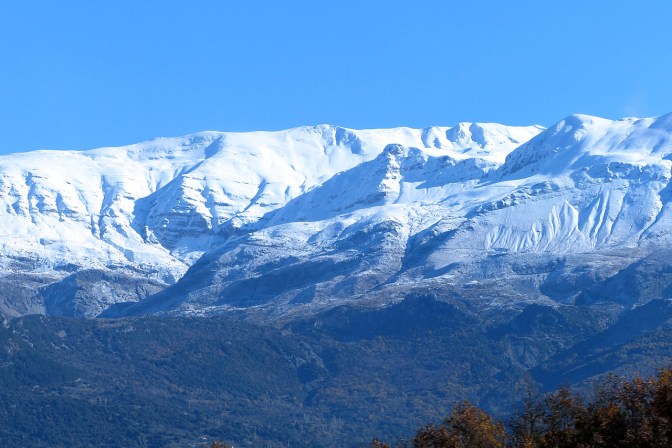
Two hours later we got off the bus in Kalabaka with the eternal regret of having taken it as the weather conditions returned to being glorious as soon as the bus rode out of the damp, foggy bowl where Ioannina is located. The road was simply incredible and it would have been a spectacular ride. However, the decision had been made and the regret will fade. We have a good excuse to return.

Kalabaka is the place of Meteorea, in Greek, meaning “in the heavens above.” I love the idea of that phrase. Meteorea is one of the largest and most important Eastern Orthodox complexes of monasteries in Greece, second only to Mount Athos. The six monasteries sit atop natural sandstone rock towers at the northwestern edge of the Plain of Thessaly.
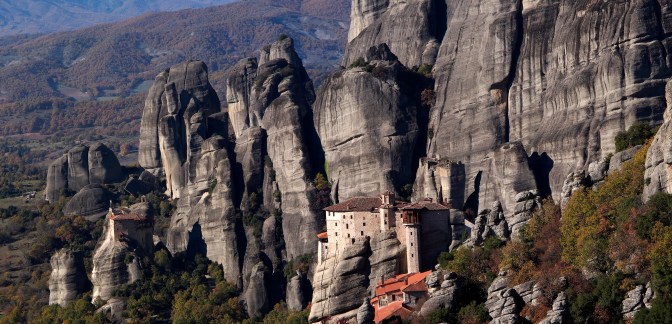
There is evidence of habitation in nearby caves dating back 50,000 years but more recently, in the 9th century, a group of hermit monks decided to move up to the towers. At first, they lived in caves and fissures of the pillars that tower up to nearly 600 metres above the plains below.

Over the centuries more than 20 monasteries were built on top of the towers behind Kalabaka. Only six remain today: four inhabited by monks and two by nuns, with fewer than 10 inhabitants in each.

Walking among the towers, climbing the narrow, carved stairs into them to one of the monasteries, it’s easy to understand why they were built there. Difficult to access and easy to defend. Solitude pretty much guaranteed. But it is also a place of great beauty and the name is apt as the monasteries are indeed in the heavens.

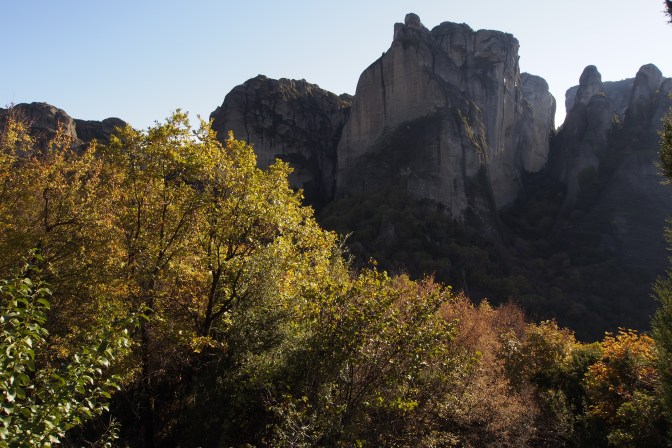

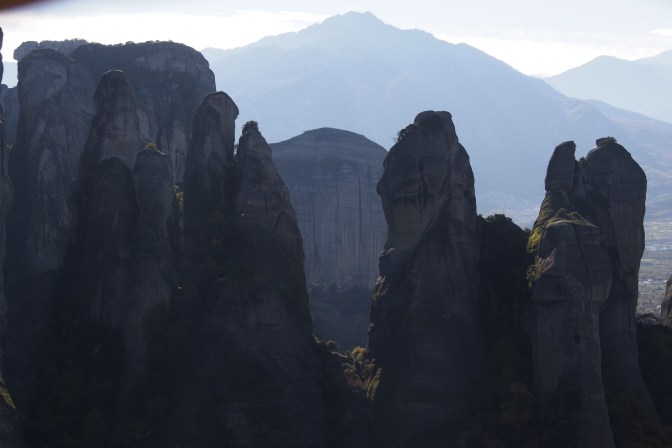
It is one of those places that has a kind of a magnetic pull, making it hard to tear yourself away. We could have spent a week there, visiting all the monasteries, wandering among the cliffs and towers, exploring the canyons and seeking out the tops on a quest for better views.

We did stay another day and were lucky to have a gorgeous sunny one to explore. We visited one monastery and tried to get into another but it was closed for two hours at midday, so instead we chose to go hiking into one of the canyons between the towers. It was a magical day.

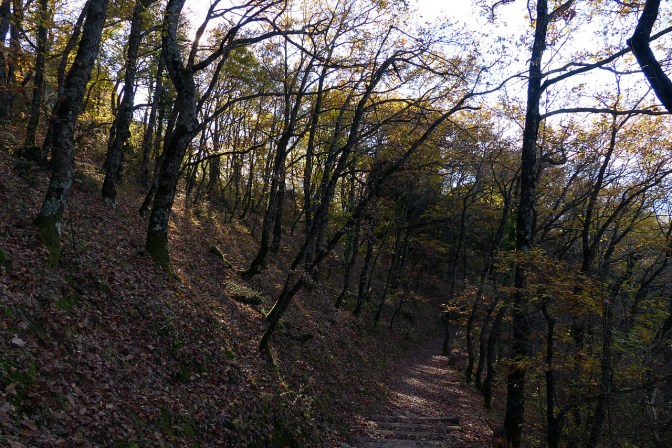
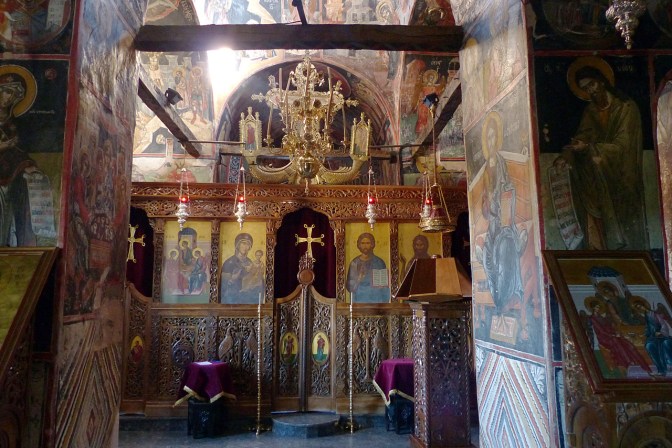
The fall foliage and the bright blue sky above provided a riot of colour between the uniform beige-brown of the sandstone towers. There were not many other people around so it was quiet, a perfect way to be in this place where, even as a non-believing atheist like me, you can’t help but feel you are in a spiritual place.

I understand why the monks wanted to be on top of these towers. There were the practical reasons, which were at the same time highly impractical, as everything had to be carried up. And when it couldn’t be carried any longer, it had to be hauled up with ropes. Despite how difficult it must have been to live and build up there, the sheer height of the towers put them in the heavens and closer to God. And if that didn’t do it for them, the utter beauty of the place would have brought them closer to their God.
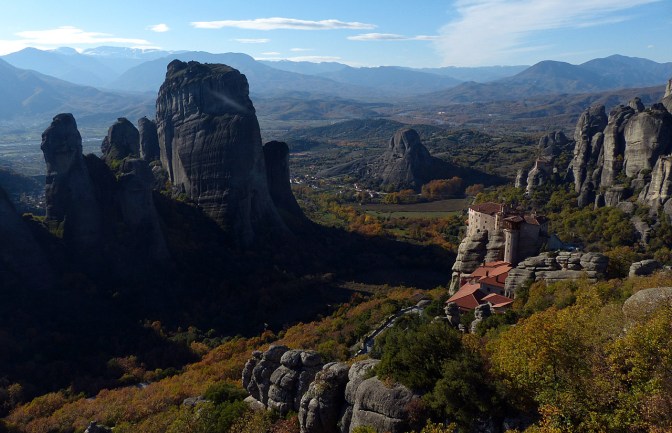
We tore ourselves away the next day by cycling the steep road up from Kalabaka to the village of Vlachava north of Meteorea. After a short rest and a coffee in the café, we carried on as a light drizzle began. We were still climbing and approaching 1,000 metres above sea level. The temperature dropped and the rain steadily increased and it did not take long before we realized that cycling any great distance under these conditions was foolhardy and difficult.

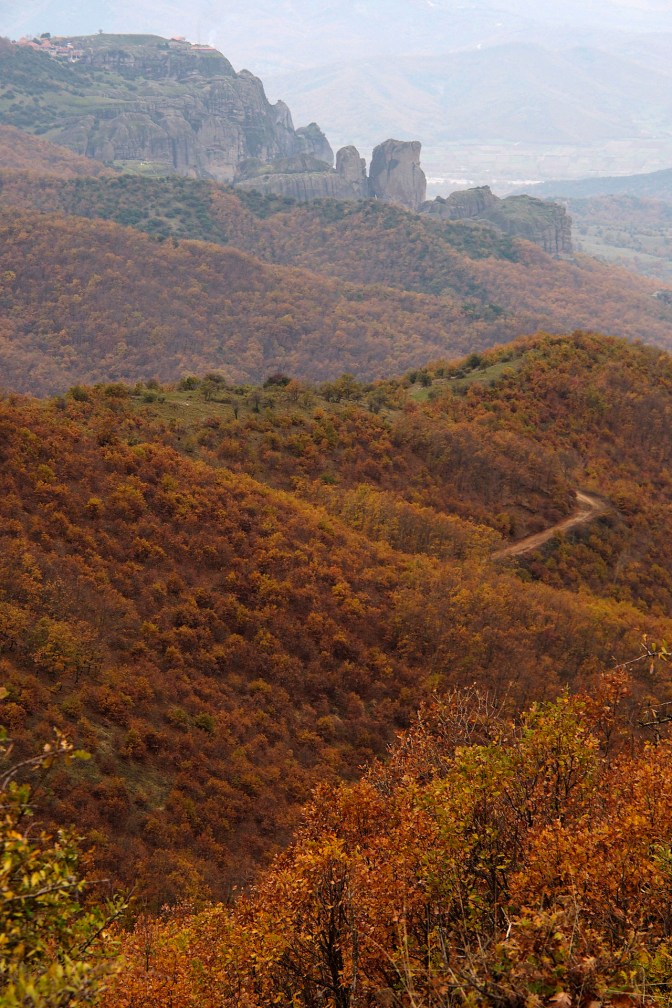
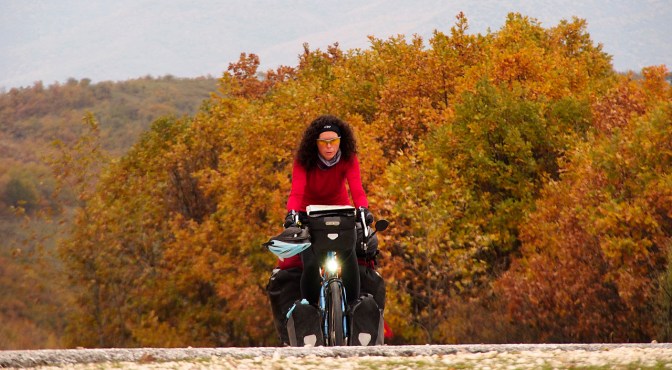
We got as far as Deskati, about 50 KM from Kalabaka. We were completely soaked, cold and spent. The town seemed like it was shut down. Nobody around. The only hotel we could find was closed but the owner of a pizza joint said it was open and called the owner for us. Meanwhile, Jan walked down the street to see if there was a bus we could take to Elassona as we had arranged accommodation there already.

As I’m talking to the owner of the hotel, trying to explain we needed one room and, yes, only one night, Jan came running back to tell me the bus was there and waiting. We made hurried apologies to the hotel owner, thanked her and the pizza guy, and raced down to the bus stop. The driver was great, helping us get the bikes and the gear into the luggage compartments and in no time we were off to Elassona, the largest town in the region.
We had booked accommodation there through Warm Showers, an online accommodation and information network for cyclists. Our host, Yannis, was expecting us and I texted him to let him know we were en route. It was amazing how everything just fell into place that day. We were happy to be in a warm, dry bus while outside the cold winter rain came down in sheets.

An hour later, Yannis met us at the Elassona bus station and guided us to the home he shares with his parents. We were welcomed with open arms. All our wet stuff was hung up to dry on chairs and radiators and we both had a hot shower to warm up.
The generous hospitality of this family was amazing and is the epitome of the Warm Showers concept which is free, reciprocal and based on mutual trust. If you are not familiar with it, you can check warmshowers.org
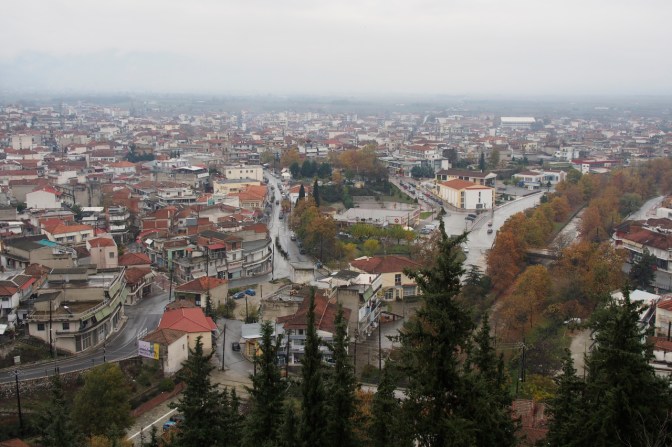
We had a family dinner of soup, followed by stuffed peppers, stuffed tomoatoes, potatoes, bread and salad and a glass of wine. Very yummy and generous. Momma insisted we finish it. Afterward, Yannis took us out to one of his local hang-outs, a very stylish café playing nice jazz and hopping with locals most of whom know Yannis in this town of about 7,000.
Yannis works hard promoting cycling in Elassona. Another cyclist who stayed with him a few weeks ago called him the Bike Guru of Elassona. With permission from the mayor, he has taken six old bikes and spray-painted them bright neon colours, hung planters off them and located them in high-traffic, visible locations around the city.
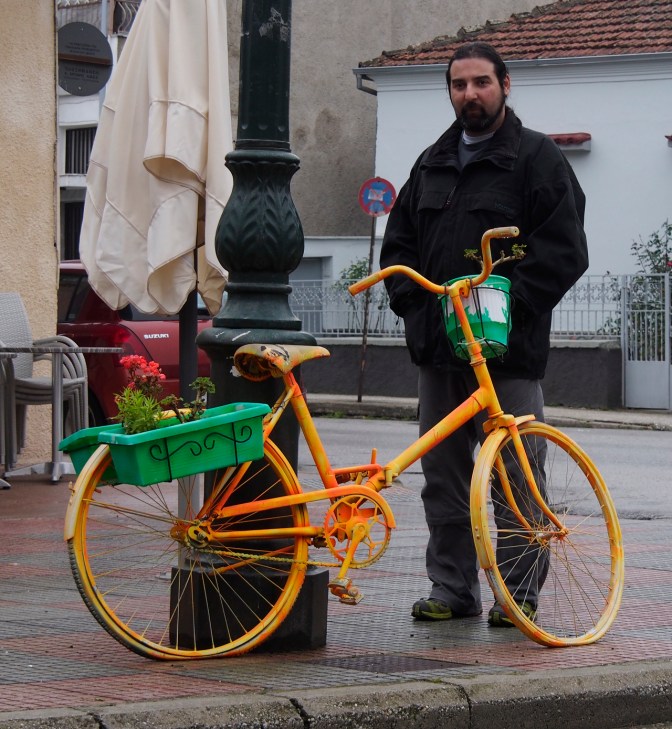
He has a complete workshop in the attic of the family house where he does bicycle repair and maintenance for friends and restores old bicycles, focussing on typical Greek models – heavy and sturdy work bikes – dating back 50 years or more. He has won awards for his restoration work at various shows. They are beautiful. Check out his web site.
The Greek economic situation is visible everywhere in Greece, including Elassona, as many storefronts are boarded up because shop owners just couldn’t make ends meet any longer. Unemployment is high and despite what you may read in the papers, people told us there is no quick fix to the problems in Greece because they are structural and need more than just a monetary bailout. A complete overhaul of the tax system and society in general is necessary to move this country back on solid footing.

Yannis had other Warm Showers guests coming in a day early so the following day we vacated his family home and took a bus to Thessaloniki, Greece’s second city. The weather was still atrocious and we only had two days to get there which we could not possibly manage.
Unfortunately, we imposed a deadline on ourselves to get to Thessaloniki by booking a flight to Amsterdam to attend the wedding of my cousin Anneloes. We decided not to cycle through The Netherlands on our way south but instead use this opportunity to visit with family and friends all at once at the wedding.
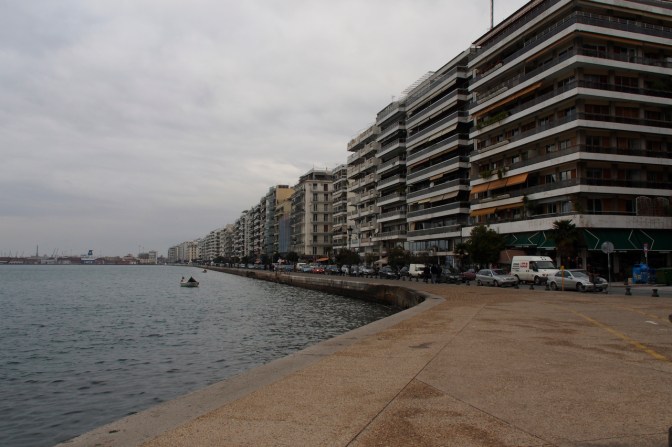
So, we arrived In Thessaloniki that evening and found our way through the busy traffic to our hotel in the dark. We stayed the next day and night to explore. We also desperately needed some clothes to wear at the wedding as nothing we’re carrying would have been suitable for that occasion.
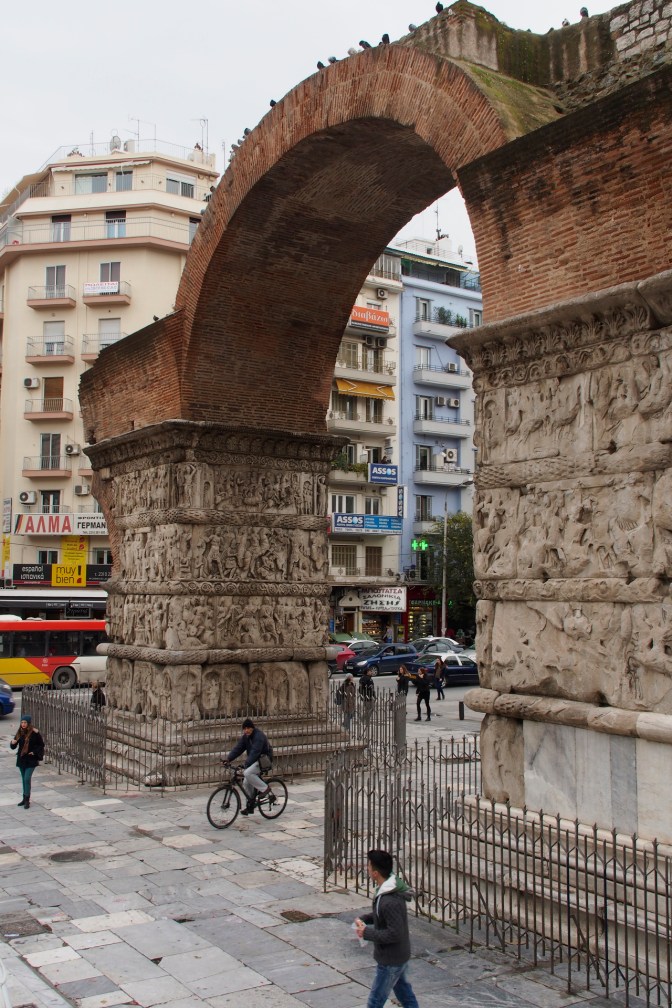

Thessaloniki is a spread-out metropolis on the coast with a million or more people. It was once the capital of the eastern Roman empire and the remnants of a grand castle, complete with a 500-metre-long hippodrome, are visible in the centre of the city.

Most of it was buried and built over but some small pieces remain. The rest is under the buildings that now occupy the space. It’s a crumbling heap of rubble, really, but there are some mosaics that have been unearthed that were part of the palace floor. It’s a shame that there doesn’t seem to be the money or the inclination to do more with it.
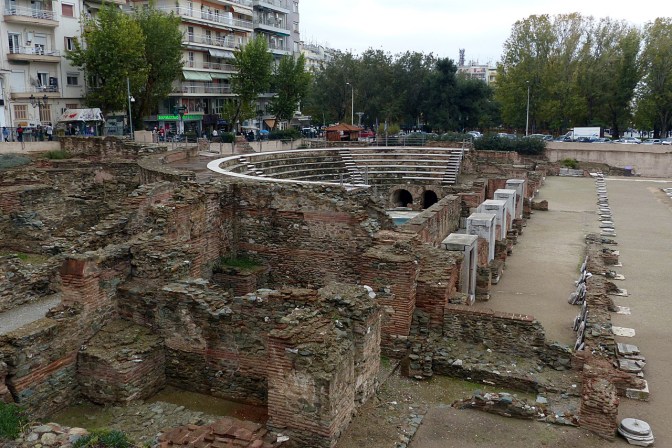
Thessaloniki’s traffic situation is grim. There is very little parking so people double and triple park their cars which ties up traffic and I had the feeling the city was just in a constant state of gridlock.


Jan and I both managed to buy outfits for a good price and the following day packed up the bikes for a short ride to another Warm Showers host about 35 KM northwest of the city. Vasilios and Ariadni, avid cyclotourers themselves, live on a hill overlooking the valley below with Mount Olympus as a backdrop. They had agreed to put us up and keep our bikes and gear for the week while we went off to party in Holland. More on that in the next post.
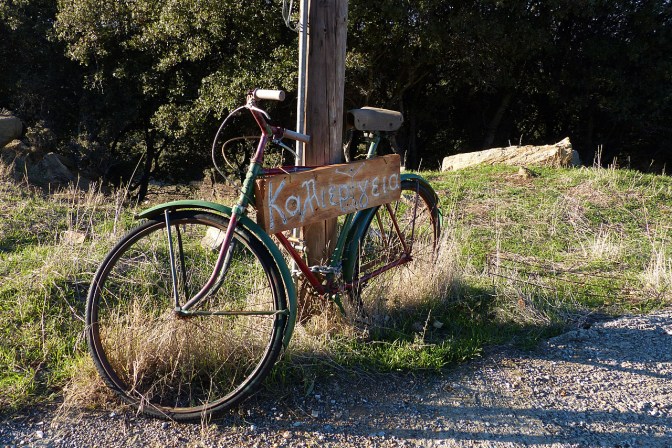

Great photos! I visited Meteorea in 1979 and loved it. Have fun at the wedding. Looking forward to pictures of you ‘cleaned up” or should i say. fancied up..xox
Bird
Stay tuned for the fancy version of us.
Still enjoying your travel stories! Have a nice time in Holland! Greetz Dianne
Thanks, Dianne. Glad you’re still reading them.
love Yannis cool bikes! Meteora is going on my list of must go to places, it looks amazing. Have fun in the Netherlands!
Cathy